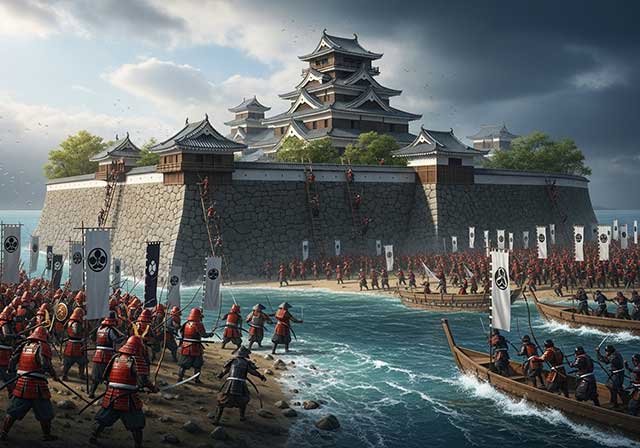
In 1551, Sue Harukata overthrew Ouchi Yoshitaka and effectively took control of the Ouchi clan, ruling it through Ouchi (Otomo) Yoshinaga, who was submissive to his will.
In 1554, Mori Motonari rose up against Sue. In June of that year, he defeated Sue's army at the Battle of Osikihata. After this victory, Motonari moved to Miyajima (Itsukushima) Island, where he began construction of Miyo Castle. In 1555, he stationed his garrison in this fortification.
Motonari then began to implement a carefully thought-out plan. He spread rumors that the new fortress was vulnerable to attack by Sue's troops. Harukata believed these rumors and transported his army by junks to the island, where he managed to capture the fort. Meanwhile, Motonari, continuing to carry out his plan, captured the Sakarao fortress on Honshu, which belonged to Sue. In this way, he cut off Harukata's troops, trapping them on a small island.
After that, Motonari waited for the right moment to deliver the decisive blow. Sue's warriors were so confident in their own safety that they even stopped posting sentries. On a rainy October night, Motonari, with the support of the Murakami family, who provided him with pirate ships, transported his army to the island. Once there, he divided his forces into two detachments. The first detachment, commanded by Motonari himself and his sons, Mori Takamoto and Kikkawa Motoharu, bypassed the fortress from the north. The second detachment, led by Motonari's other son, Kobayakawa Takakage, secretly headed for the main gate of the castle.
Although Motonari's army was several times smaller than Sue's, he had the main advantage on his side: surprise. At dawn, both groups of attackers launched their assault from different directions. Sue's soldiers were caught off guard and tried to flee in panic, but all the ships had been taken away in advance by the Murakami pirates.
Hundreds of Harukata's soldiers committed suicide: some threw themselves into the water, others resorted to traditional seppuku. Following their example, Sue Harukata also took his own life. This victory marked the beginning of the rise of the Mori clan as rulers of western Japan.
See also
-
The Siege of Hara Castle

The Shimabara Rebellion of 1637–1638, which culminated in the siege of Hara Castle, was the last major uprising of the Edo period and had serious political consequences.
-
Battle of Tennoji

The confrontation between Tokugawa Ieyasu and Toyotomi Hideyori during the “Osaka Winter Campaign” ended with the signing of a peace treaty. On January 22, 1615, the day after the treaty was signed, Ieyasu pretended to disband his army. In reality, this meant that the Shimazu forces withdrew to the nearest port. On the same day, almost the entire Tokugawa army began filling in the outer moat.
-
Siege of Shuri Castle

The Ryukyu Kingdom was established in 1429 on Okinawa, the largest island of the Ryukyu (Nansei) archipelago, as a result of the military unification of three rival kingdoms. In the following years, the state's control spread to all the islands of the archipelago.
-
The Siege of Fushimi Castle

Fushimi can perhaps be considered one of the most “unfortunate” castles of the Sengoku Jidai period. The original castle was built by Toyotomi Hideyoshi in the southeast of Kyoto in 1594 as his residence in the imperial city.
-
The Siege of Otsu Castle

The siege of Otsu Castle was part of the Sekigahara campaign, during which the so-called Eastern Coalition, led by Tokugawa Ieyasu, fought against the Western Coalition, led by Ishida Mitsunari. Otsu Castle was built in 1586 by order of Toyotomi Hideyoshi near the capital Kyoto, on the site of the dismantled Sakamoto Castle. It belonged to the type of “water castles” — mizujō — as one side of it faced Japan's largest lake, Lake Biwa, and it was surrounded by a system of moats filled with lake water, which made the fortress resemble an island.
-
The Siege of Shiroishi Castle

The siege of Shiroishi Castle was part of the Sekigahara campaign and took place several months before the decisive battle of Sekigahara. The daimyo of Aizu Province, Uesugi Kagekatsu, posed a serious threat to Tokugawa Ieyasu's plans to defeat the Western Coalition, and Ieyasu decided to curb his actions with the help of his northern vassals. To this end, he ordered Date Masamune to invade the province of Aizu and capture Shiroishi Castle.
-
The Second Siege of Jinju Castle

During the two Korean campaigns of the 16th century, the Japanese repeatedly had to capture enemy fortresses and defend occupied or constructed fortifications from the combined Korean and Chinese forces. Among all the operations of that time, the second siege of Jinju Castle is considered the most interesting from the point of view of siege warfare.
-
The Siege of Takamatsu Castle

The siege of Takamatsu Castle in Bitchu Province is considered the first mizuzeme, or “water siege,” in Japanese history. Until then, such an original tactic had never been used.

